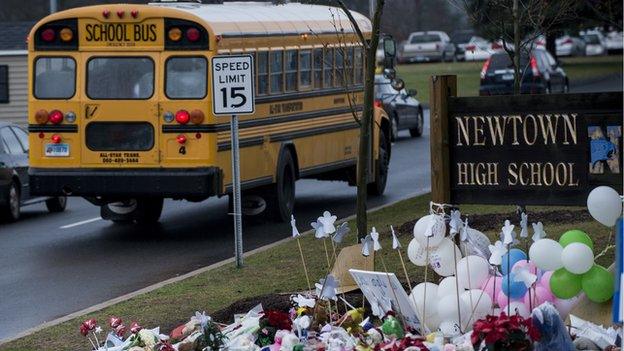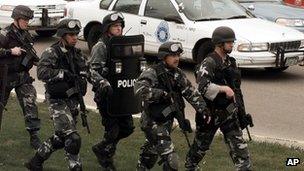Newtown shooting: Keeping schools safe
- Published

In the years since the Columbine High School killings, US law enforcement and schools have tried to prevent mass shootings. Does anything work?
As the news of the shootings in Newtown, Connecticut spread across the US, news channels and web sites filled up with information for parents wondering: how on earth do I explain this to my child?
But while terror is not part of their everyday lives, most children have had some inkling that a terrible event is possible at their school, thanks to updates in school safety planning and curriculum changes put in place in response to over a decade of mass school shootings
Just as children in the Cold War took part in "duck-and-cover" drills to prepare for nuclear attack, most states require schools to hold lockdown drills, says Paul Timms, president of RITA security, a consulting firm that specialises in school security.
The drill kicks off with an announcement over the school's public address system requesting that teachers secure their classroom.
"First thing you do is lock your door," says Timms. "Then move the students to the part of the classroom where you cannot see from the hallway. You might turn off the lights. You make sure the students are quiet, then wait for the few minutes it takes to make sure rooms are locked and doors are quiet. Then there's a second announcement [giving] the all clear."
These drills have become commonplace in the wake of mass shootings, and not just for educators.
A week before the Newtown shooting, another gunman opened fire at the Clackamas Town Center shopping mall in Portland, Oregon. He killed two shoppers then shot himself to death. Officials say the casualties were much lower thanks to active, external practiced at the shopping centre both by store employees and security staff.
"Active-shooter training blossomed after the Columbine attack in 1999," says Frank Borelli, a 30-year veteran of law enforcement, active-shooter instructor, and editor for Officer.com. He says even local law enforcement agencies around the country implemented new training and policies after Columbine.
"It was due to the outrage people felt after Columbine: police took up the perimeter and took cover while they waited for the Swat team to come," he says. While securing a safe perimeter and waiting for reinforcements was standard protocol, "kids got killed after police were on the scene", he notes.
Since then, protocol has promoted taking down an active gunman as soon as possible. "Cops are trained to go hunting," says Borelli. "We don't train to arrest active shooters."
Experts now say that not training for the appearance of an active gunman would put schools, shops, police and other public institutions at risk of liability in the event that something does go wrong.

Swat teams performed several sweeps of Columbine High School in 1999
It's also one of the few tangible changes that have made a marked difference. The efficacy of preventative safety measures designed to prevent these attacks are much harder to measure.
After Columbine, for instance, students had to start wearing identification tags showing they were Columbine students in order to gain access to the school - even though the gunmen attended Columbine
"They could have come in and done this just the same, but somehow we all feel better because they had name tags," says Carolyn Mears, whose son attended the school in 1999.
In fact, says Mears, author of Reclaiming Schools in the Aftermath of Trauma, many of the fixes proposed by the community after Columbine were what she calls "Band-Aid" fixes rooted in good intentions, but not sufficient.
The shootings prompted calls for a "no-bully policy", she says.
"Well, [the school] already had that. You had to institute a zero-tolerance policy, they had that too.
"A lot of the things that have been done have been to make parents feel better, to make the community feel safer."
Whether they are safer is hard to say.
Schools have launched an admirable attempt to help identify and address problems with school culture that may exacerbate violence, and especially to try to come to the aid of vulnerable students who may be capable of violence, says Katherine Newman, dean of the arts and sciences at Johns Hopkins University and co-author of Rampage: The Social Roots of School Shootings.
The problem, she says, is that the causes of these shootings are so complex that they are difficult to address in easily-digestible school policy.
"There is more attention to the oddball child, but never enough," she says.
And so security becomes the fallback. Security, though, can only do so much.
Despite their "presumably expensive", newly-installed security system, Sandy Hook Elementary School was vulnerable to an outside attacker, says David Altheide, the Emeritus Regents' Professor in the School of Justice and Social Inquiry at Arizona State University,
"It doesn't mean we shouldn't still be cautious and still have teachers have some sense, but ultimately you're really only going to be so safe."
Most schools, he says, are very safe places for children. And safety experts like Timms and sociologists like Mears try to prevent shootings and protect students should the unthinkable happen.
In the end, safety experts say, you can't hope to eliminate risks, only minimise the damage they cause. But in the aftermath of a school shooting, the damage is always too great.